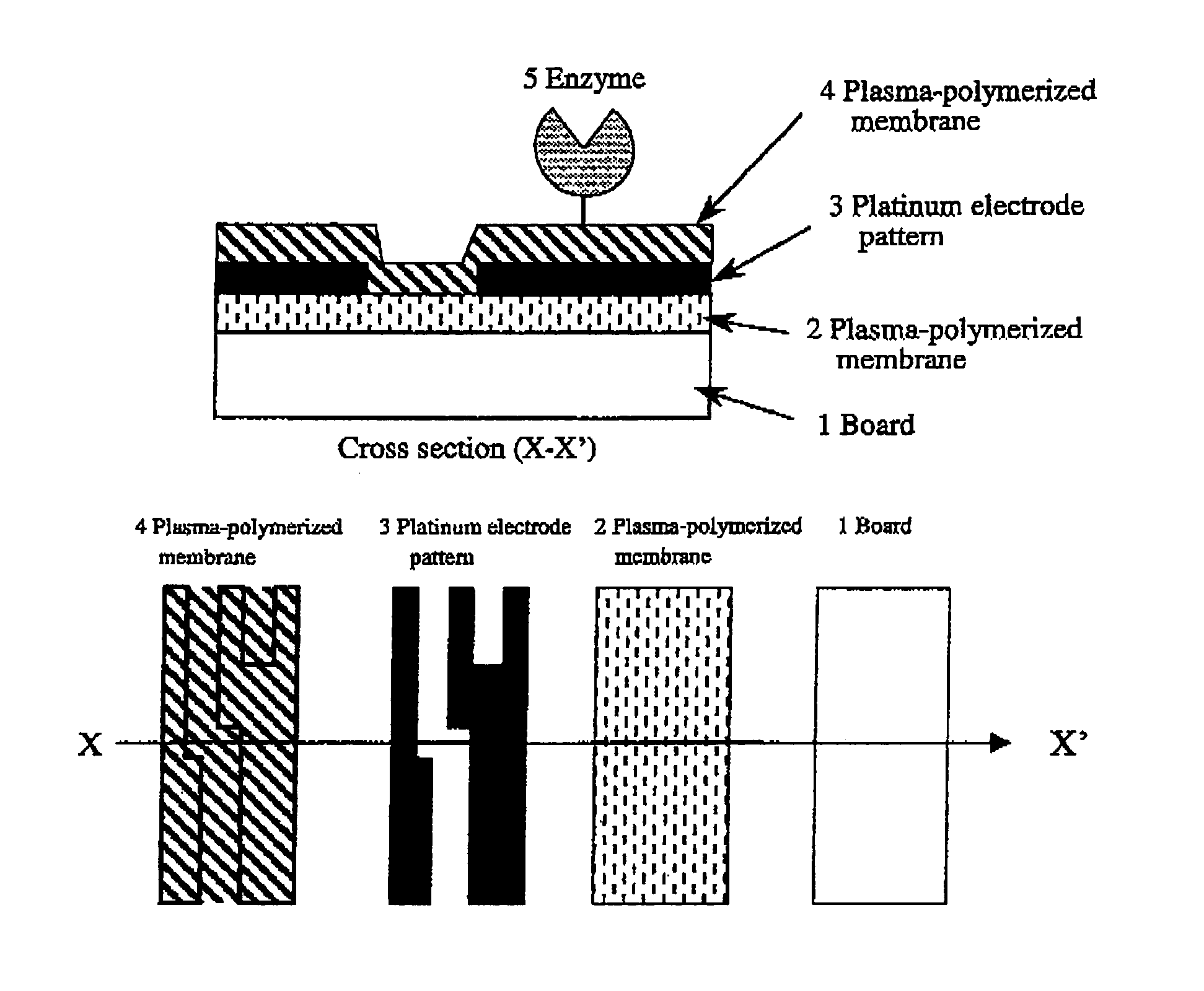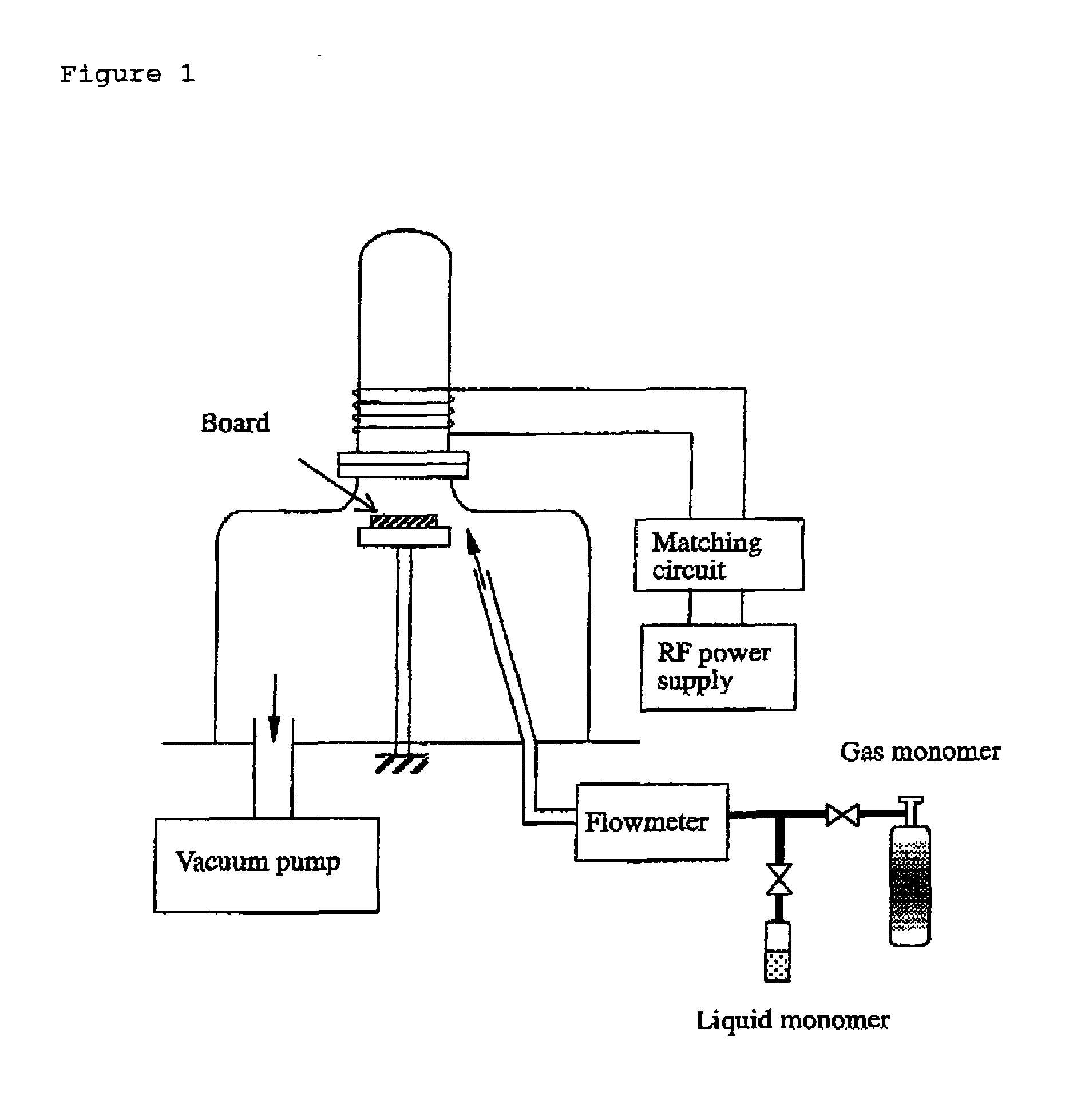Biosensor
a biosensor and mediator technology, applied in the field of biosensors, can solve the problems of difficult to completely immobilize the mediator-type biosensor, the low molecule weight mediators used for the mediator-type biosensors are difficult to achieve, and the detection may not be sufficiently oxidized. , to achieve the effect of excellent mass-productivity and superior respons
- Summary
- Abstract
- Description
- Claims
- Application Information
AI Technical Summary
Benefits of technology
Problems solved by technology
Method used
Image
Examples
example 1
[0120]This is an example of a biosensor of the present invention, a glucose sensor using GOD. Structure of the glucose sensor of the present invention is shown in FIG. 2. The manufacturing process was as follows: A glass board was washed and an approximately 100 nm-thick plasma-polymerized membrane (1) was formed on the board using hexamethyldisiloxane. Conditions for plasma polymerization were as follows:
Flow rate: 15 cm3 / min,
Discharge power: 40 W,
Pressure: 4.6 Pa,
Discharge time: 1 min.
[0121]Then, an approximately 100 thick platinum electrode pattern (2) was formed with the spatter method using a mask. The mask was removed and then an approximately 50 nm-thick acetonitrile plasma-polymerized membrane was formed. Conditions for this plasma polymerization were as follows:
Flow rate: 15 cm3 / min,
Discharge power: 80 W,
Pressure: 2 Pa,
Discharge time: 1 min.
[0122]Amino groups are present at a high density on the surface of this membrane. Using these amino groups, the enzyme was immobilized ...
example 2
[0131]Electrode response characteristics of the platinum electrode pattern on the plasma-polymerized membrane were examined. With the glucose sensor shown in FIG. 2, with the board (1), plasma-polymerized membrane (2) and thin platinum membrane (3) and without immobilizing enzyme, responses to H2O2 of different concentrations were measured. Results are shown in FIG. 5. Silver / silver chloride was used for the reference electrode. Sweep rate was 50 mV / s. The result indicates that the platinum electrode of the present invention shows a favorable electrode response to H2O2. Also, it does not detach even after being immersed in the solution for a long period of time. Thus, the platinum electrode formed on the surface of the plasma-polymerized membrane has sufficient characteristics as an electrode for a biosensor. In contrast, platinum electrodes formed on glass or plastic boards detach easily when immersed in water.
example 3
[0132]Presence of amino groups on the acetonitrile plasma-polymerized membrane (4) was confirmed. To confirm presence of amino groups on the surface of the membrane, the following experiment was conducted: the membrane surface was exposed to vapor of pentafluorobenzaldehyde, an agent that specifically reacts with amino groups, for 8 hours and then x-ray photoelectron spectroscopy was performed. As a result, approximately 7% or more fluorine atoms were detected on the surface. The presence of fluorine atoms of the modulating agent indicates that pentafluorobenzaldehyde has specifically reacted with amino groups on the membrane surface. It means that amino groups are present at a high density on the surface of the acetonitrile plasma-polymerized membrane. These amino groups can be used to immobilize enzymes covalently.
PUM
| Property | Measurement | Unit |
|---|---|---|
| Molar density | aaaaa | aaaaa |
| Molar density | aaaaa | aaaaa |
| Molar density | aaaaa | aaaaa |
Abstract
Description
Claims
Application Information
 Login to View More
Login to View More - R&D
- Intellectual Property
- Life Sciences
- Materials
- Tech Scout
- Unparalleled Data Quality
- Higher Quality Content
- 60% Fewer Hallucinations
Browse by: Latest US Patents, China's latest patents, Technical Efficacy Thesaurus, Application Domain, Technology Topic, Popular Technical Reports.
© 2025 PatSnap. All rights reserved.Legal|Privacy policy|Modern Slavery Act Transparency Statement|Sitemap|About US| Contact US: help@patsnap.com



